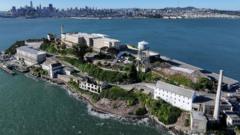In a bold move, US President Donald Trump has reinforced his suggestion to revive Alcatraz, the historic prison island located in the chilly depths of San Francisco Bay. Known historically as "the Rock," its doors have been shut to inmates since 1963, with the prison now serving as a thriving tourist hotspot. Trump envisions this monumental site as a renewed facility capable of housing dangerous criminals, symbolizing a strong approach to law and order. However, critics have raised pointed concerns about the feasibility of remodeling the deteriorating infrastructure.
Originally established as a coastal defense fort, Alcatraz evolved into a federal penitentiary in 1934. This notorious institution housed infamous criminals such as Al Capone and George "Machine Gun" Kelly, becoming synonymous with inescapability due to treacherous waters guarding its perimeters. The facility gained further fame through Hollywood, featuring in various films, including Clint Eastwood's "Escape from Alcatraz."
Despite Trump's fervent discussions of reopening Alcatraz, history shows that previous proposals to repurpose the island for correctional purposes have repeatedly faltered. In the early 1980s, the Reagan administration considered Alcatraz a potential site for holding Cuban refugees, but this plan was dismissed in favor of preserving its historical and tourist value.
Recently, Trump asserted on Truth Social that reopening Alcatraz is not merely an idea but a necessity, stating, "We need law and order in this country." With dining facilities and infrastructure long since abandoned, experts remain skeptical about the prospects of resuscitating such a facility. According to former prison administrators and historians, the cost of revitalization would be exorbitant. They highlight undeniable challenges: crumbling infrastructure, inadequate sanitation systems, and a complete lack of modern security features.
Chad Gilmartin, spokesperson for the Justice Department, announced that efforts are indeed underway to review the practicalities of reopening the prison. Nevertheless, insiders question the viability of these plans. Hugh Hurwitz, former acting director of the Bureau of Prisons, deemed the idea unrealistic given the potential renovation costs and the facility’s deteriorating conditions.
Others, like author Jolene Babyak, stress the unsustainability of current logistics, noting that waste disposal and basic necessities would pose major hurdles. Today’s operational expenses already far exceed what they were during Alcatraz's prime, suggesting that even a functional plan could skyrocket costs to unprecedented levels.
This extensive history and serious logistical concerns place Trump's Alcatraz dream in a precarious light, prompting many to wonder if this is yet another chapter in the storied, complex saga of one of America's most renowned landmarks.




















